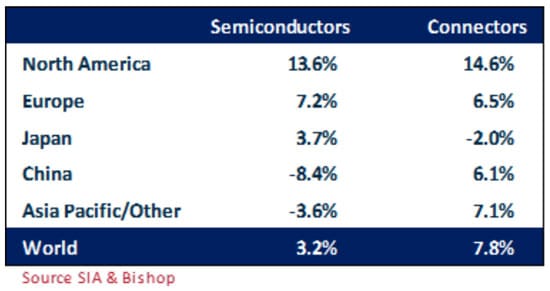This article prepared by Ron Bishop and published by TTI Market Eye summarizes trends in 2022 connector market and semiconductors.
The Semiconductor Industry Association (SIA) reported December 2022 sales of $45.5 billion, down 14.7 percent from the prior year and down 4.4 percent sequentially. Regionally for December, the SIA reported that the Americas contracted 6.6 percent year-over-year (YOY), China decreased 26.4 percent and Asia Pacific/Other decreased by 13.9 percent. Europe increased 3.3 percent and Japan increased 0.5 percent. For 2022, sales increased 3.2 percent YOY to $573.5 billion worldwide.
Connector industry sales in December were down 0.9 percent from the prior year and decreased 10.0 percent sequentially. Regionally for December, YOY sales increased 4.2 percent in North America, 2.4 percent in Europe, 0.0 in Asia Pacific and 4.4 percent in ROW. Japan decreased 13.9 percent YOY and China decreased 6.5 percent. For 2022, sales increased 7.8 percent to $84.1 billion.
The featured graph compares semiconductor sales performance to the connector industry since August 2021.
Connector sales growth was higher than semiconductors for the fifth month in a row. Semis sales growth has been negative for four consecutive months.
The following table displays year-to-date performance, measured in U.S. dollars, by geographic region for both components.

Some interesting trends include:
- The semiconductor industry’s full year 2022 sales increased 3.2 percent. Connectors achieved 7.8 percent growth.
- The connector industry outperformed semis for the past five months. Since semi demand leads connectors by several months, we can expect the connector industry to also report declines.
- Global inflation was in the 8 percent to 10 percent range. This suggests that neither industry achieved growth in units.
China’s ongoing battle with COVID variants is continuing to cause periodic lockdowns, which in turn is impacting the manufacturing and exporting of materials and components to other countries. The most recent news is that China has ended their stringent quarantine rules/testing and reopened their borders in spite of COVID cases presently infecting up to 70 percent of residents in places like Shanghai. The U.S. ban on selling any high-end AI chips to any entity operating in China will also affect China’s growth in electronics.
Many countries have made progress in reviving their economies from the first COVID era, but worldwide inflation is affecting all regions and markets. Although recession is still a possibility, economists are more optimistic that we could avoid one. The year-over-year growth will continue to slow, however, as the comparisons are difficult and the worldwide economies slow.
Bishop & Associates, incorporated in 1985, is the leading research firm on the connector industry. The Bishop Report is a monthly newsletter that tracks the performance of the industry. To learn more, or to subscribe, follow this link.